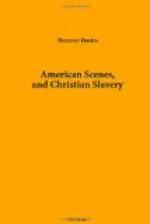We move down stairs. The immense procession starts. Drs. Cox and Patton, Mr. Hatfield, and about half-a-dozen more white ministers, are in it. As we pass on from street to street, and from crossing to crossing, all sorts of people seem to regard the procession with the utmost respect. The cabmen, ’busmen, and cartmen behave exceedingly well. But did you overhear what those three or four low dirty men said as we approached? I am ashamed to tell, because those men are not Americans, but Irishmen,—“Here comes the dead nigger!” The boys, now and then, are also overheard counting how many white men there are in the procession.
We are now at the church. After much delay and difficulty we enter. The place, which is not large, is crammed. There must be about 600 people in. Dr. Cox urges them to make room for more, and says there are not more than one-tenth in of those who wish to enter. If so, there must be a concourse of 6,000 people, and not more than twenty whites among them all!
A coloured man gives out a hymn. Dr. Cox reads the Scriptures, and makes a few remarks. Dr. Patton delivers an oration. In that oration, while speaking of Mr. Wright’s anti-slavery feelings as being very strong, he adds, with very questionable taste, “But at the same time our brother had no sympathy with those who indulged in denunciation, wrath, and blackguardism. He would never touch the missiles which none but scoundrels use.” What a selection of words in a funeral oration! In speaking of Mr. Wright’s labours in connection with that church for fifteen years, he says, “Our brother had difficulties which other men have not. Two or three years ago he had to trudge about the city, under the full muzzle of a July or August sun, to beg money in order to extricate this place from pecuniary difficulties. On one occasion, after walking all the way to the upper part of the city to call upon a gentleman from whom he hoped to receive a donation, he found that he had just left his residence for his office in the city. Our brother, though greatly exhausted, was compelled to walk the same distance down again; for—to the shame, the everlasting shame of our city be it spoken—our brother, on account of his colour, could not avail himself of one of the public conveyances. The next week disease laid hold of him, and he never recovered.”
What a strong and unexpected testimony against that cruel prejudice! According to this testimony, Theodore Sedgwick Wright fell a victim to it. But who would have thought that Dr. Patton, who thus denounced the cabmen and ’busmen of New York, had at the very time the “Negro Pew” in his own church!




